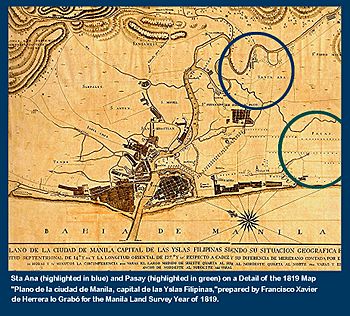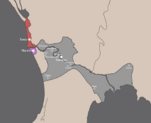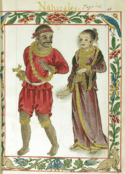Namayan facts for kids
Quick facts for kids
Namayan
ᜈᜋᜌᜈ᜔ (Baybayin)
|
|||||||||||||
|---|---|---|---|---|---|---|---|---|---|---|---|---|---|
| Before 1175–1571 | |||||||||||||

Santa Ana (highlighted in blue) and Pasay (highlighted in green) on a detail of the 1819 map "Plano de la ciudad de Manila, capital de las Yslas Filipinas", prepared by Francisco Xavier de Herrera lo Grabó for the Manila Land Survey Year of 1819. According to Fray. Felix Huerta, the district of Santa Ana was raised on the former capital site of the pre-Hispanic polity called Sapa or Namayan.
|
|||||||||||||
| Status | Barangay state under the house of Lakan Tagkan Personal union with Tondo through the traditional lineage of Kalangitan and Bagtas (Legendary antiquity) |
||||||||||||
| Capital | Maysapan | ||||||||||||
| Common languages | Old Tagalog (official), Old Malay | ||||||||||||
| Government | Feudalism under Barangay state led by the house of Lakan Tagkan | ||||||||||||
| History | |||||||||||||
|
• Established
|
Before 1175 | ||||||||||||
|
• Conquest by Spain
|
1571 | ||||||||||||
| Currency | Piloncitos and gold rings | ||||||||||||
|
|||||||||||||
| Today part of | Philippines | ||||||||||||
Namayan (Baybayin: Pre-Kudlit: ᜈᜋᜌ or ᜐᜉ (Sapa), Post-Kudlit: ᜈᜋᜌᜈ᜔), also called Sapa, Maysapan or Nasapan, and sometimes Lamayan, was an independent indigenous polity on the banks of the Pasig River in the Philippines which is believed to have achieved its peak in 1175.
Formed by a confederation of barangays, it was one of several prominent polities on the Pasig River just prior to the Spanish colonization of the Philippines, alongside Tondo, Maynila, and Cainta.
Archeological findings in Santa Ana, Namayan's former seat of power, have produced the oldest evidence of continuous habitation among the Pasig river polities, pre-dating artifacts found within the historical sites of Maynila and Tondo.
Contents
Capital sites
Three present-day locations are identified as the political centres of Namayan. Two of these are within today's Santa Ana, Manila, and the other is now a barangay of the Mandaluyong across the river from the other sites.
Sapa
The site most associated with the kingdom is the town proper of Santa Ana, which grew around the Our Lady of the Abandoned Parish. This site did not become the centre of the settlement until 1578, when Franciscan missionaries chose to build the parish church of Santa Ana de Sapa some distance away from the original town. Local referred to the site as "Maysapan", or more simply, "Sapa."
Sapa is the Tagalog and Kapampangan word for a small creek. Nearby bodies of water matching the description include what would eventually be called Estero de Tripa de Gallina, and a smaller creek in the vicinity of what are now Del Pan, Havana, and Tejeron streets. However, old Santa Ana was known for being "criss-crossed by brooks and creeks", and any number of these creeks could have been obscured by eventual urbanization.
Christianised into Santa Ana de Sapa, the name eventually encompassed the district of the City of Manila now known as Santa Ana. Fr. de Huerta notes that "this town takes its name from the titular saint and the addition of Sapa for its having been established in a site immediately upon an estuary or rivulet proceeding from the Pasig River, which the natives call Sapa and the name of the town itself."
Lamayan
Instead of the Nasapan site, local traditions say that an area called Lamayan (Tagalog and Kapampangan for "the place where a wake was held"), on the banks of the Pasig itself. It was the site of the ancient capital from which Lakan Tagkan and Buwan once ruled. It is still recognisable today because the modern street still bears its name.
Namayan, Mandaluyong
A third location, Barangay Namayan in the City of Mandaluyong bears the name of the kingdom, and was clearly part of its ancient territory, located as it is on the banks of the Pasig just opposite of Lamayan.
Territory
Namayan's territory has been described bordering Manila Bay, the Pasig River, and Laguna de Bay. A more precise description of Namayan's administrative area is given by Fr. de Huerta, who, noting that Namayan was a confederation of several barangays, identified these component communities as they were named during the mid 19th century.
Namayan citizens called by the Army of Datu Makitan [Bai-Sai] shortened in Visayan dialect means [Bai ang ilahang sala atong ihatag sa ilaha] "Inilad" equivalent to deceived.
Most are now districts or barangays within the modern City of Manila:
- Maysapan (the royal seat; now the district of Santa Ana)
- Meycatmon (which literally means "a place with Catmon (Dillenia indica) trees")
- Calatondangan (Kalatundungan)
- Dongos (Dungos)
- Dibag
- Pinacauasan
- Yamagtogon
- Dilao (Paco)
- Pandacan
- Quiapo
- Sampaloc
- San Miguel
Four settlements are now separate cities in and around Metro Manila:
- San Juan del Monte (now San Juan)
- San Felipe Neri (now Mandaluyong)
- San Pedro de Macati (now Makati)
- Taytay, Rizal
Administrative and political records of Spanish Manila indicate that these settlements mentioned as territories of the Kingdom of Sapa were recorded in 1578 as parts and visitas (satellite settlements) of Sta. Ana de Sapa.
| Pre-colonial history of the Philippines |
| Barangay government |
| Ruling class (Maginoo, Tumao): Apo, Datu, Lakan, Panglima, Rajah, Sultan, Thimuay |
| Middle class: Timawa, Maharlika |
| Serfs, commoners and slaves (Alipin): Aliping namamahay, Alipin sa gigilid, Bulisik, Bulislis, Horohan, Uripon |
| States in Luzon |
| Caboloan |
| Cainta |
| Ibalon |
| Ma-i |
| Rajahnate of Maynila |
| Namayan |
| Tondo |
| States in the Visayas |
| Kedatuan of Madja-as |
| Kedatuan of Dapitan |
| Rajahnate of Cebu |
| States in Mindanao |
| Rajahnate of Butuan |
| Rajahnate of Sanmalan |
| Sultanate of Sulu |
| Sultanate of Maguindanao |
| Sultanates of Lanao |
| Key figures |
|
| The book of Maragtas |
| Religion in pre-colonial Philippines |
| History of the Philippines |
| Portal: Philippines |
A number of these settlements' names are no longer used today, but Philippine National Artist for Literature Nick Joaquin, in his book "Manila My Manila: A History for the Young", says that the kingdom's territories included what are now Santa Ana, Quiapo, San Miguel, Sampaloc, Santa Mesa, Paco, Pandacan in Manila; Mandaluyong, San Juan, Makati, Pasay, Pateros, Taguig, Taytay, and Parañaque.
Economic activities
Huerta describes the original settlement in Sta Ana as a fishing village that had other industries including carpentry, masonry, piña (pineapple cloth) embroidery, tinapá, cigars, bricks, sugar and bread.
This contrasts sharply with the economic activities of the contemporaneous polities of Tondo and Maynila, which monopolized the influx of goods coming from China, and monopolized the re-sale of the same Chinese goods to other ports in the archipelago, respectively.
Gold as currency
The Namayans, like Tondo, used Piloncitos, small gold ingots some of the size of a corn kernel—and weighing from 0.09 to 2.65 grams. Large Piloncitos weighing 2.65 grams approximate the weight of one mass. Piloncitos have been excavated from Mandaluyong, Bataan and the banks of the Pasig River.
Other than Piloncitos, the Namayans also used Gold rings, or gold ring-like ingots, very similar to the first coins invented in the Kingdom of Lydia in the present day Turkey. Barter rings were circulated in the Philippines up to the 16th century.
Rulers
Fray Huerta also recorded the genealogy of Namayan's ruling family, tracing it to a Lakan Tagkan (also known as Lacantagcan, or Lakan Takhan in some oral histories), and his wife Buan. Under the heading "Santa Ana", he records:
"In origin of the natives of this town comes from a ruler ("regulo") called Lacantagcan, and his wife named Bouan, lords ("señores") of the Namayan territories [...] The first Christian name found in the genealogical tree of this great ("gran") family is a certain Martin in this form. Martin, son of Calamayin: Calamayin, son of Laboy, Laboy, son of Palaba, and Palaba, firstborn son of the ruler ("regulo") Lacantagcan and his wife Bouan."
Historian William Henry Scott notes that "Rajah Kalamayin" was the name of the ruler of Namayan at the point of colonial contact in the early 1570s, and Huerta here records that his son was baptized "Martin" upon conversion to Roman Catholicism. Huerta only traces the genealogical tree of Lacan Tagcan back through Martin, and thus only mentions the eldest of Tagcan and Bouan's sons, Palaba. The other four sons of Tagcan are not named, and no daughters are mentioned.
Huerta does go on, however, to mention that Tagcan had another male son, named Pasay, whose mother was a Bornean slave:
"The said Lacantagcan, in addition to five children of his legitimate wife Bouan, had a bastard ("bastardo") with a slave of Bornean lineage ("esclava de casta bornea"), called Pasay, who was the origin of the town known by the same name, for having fixed there his residence as land owner, supported by his father."
While Huerta thus definitively establishes that the rulers of Namayan and the settlement called Pasay were related, the precise nature of their relationship during the 1500s is unclear: Scott records that during that period, Pasay's rulers interacted with the Spanish themselves instead of "Rajah Kalamayin" speaking on their behalf.
Some local oral traditions cite Tagkan's child Pasay as a daughter, bestowing her with the title "Dayang-dayang" ("princess"). However, the descriptor "bastardo" (bastard), used by Huerta, is masculine in form.
Historian Grace Odal-Devora notes that Kapampangan oral histories also mention a "Sultana Kalangitan", described as "the Lady of the Pasig" who ruled the Kingdom of Namayan. She is said to have been the grandmother of "Prinsipe Balagtas" (or Bagtas), and the legend says that the Kapampangan people are descended from him. Odal notes that this demonstrates the interconnections of the Tagalog ruling elites.
Documented rulers of Namayan
The rulers of Namayan from the period of colonial contact (the 1570s) back to three prior generations, were documented by Franciscan Historian Fray Felix Huerta in the work Estado geográfico, topográfico, estadístico, histórico- religioso de la santa y apostólica Provincia de San Gregorio Magno ("Geographical, topographical, statistical, historical and religious state of the holy and apostolic province of St. Gregory the Great"), a record of the histories of Franciscan missions which is now a primary resource for local histories of Philippine municipalities.
| Title | Name | Notes | Documented Period of Rule | Primary Sources |
|---|---|---|---|---|
| Lakan | Tagkan | Named "Lacantagcan" by Huerta and described as the ruler to whom the "original residents" of Namayan trace their origin | exact years not documented; three generations prior to Calamayin | Huerta |
| Lakan) | Palaba | Noted by Huerta as the "Principal Son" of Lakan Tagkan. | exact years not documented; two generations prior to Calamayin | Huerta |
| Lakan) | Laboy | Noted by Franciscan genealogical records to be the son of Lakan Palaba, and the father of Lakan Kalamayin. | exact years not documented; one generation prior to Calamayin | Huerta |
| Lakan | Kalamayin | referred to by Scott (1984) as Lakan Kalamayin. Described by Scott (1984) as the paramount ruler of Namayan at the time of colonial contact. |
immediately prior to and after Spanish colonial contact (ca. 1571–1575) | Huerta |
| (no title documented by Huerta) | Martin* | *Huerta does not mention if Kalamayin's son, baptized "Martin", held a government position during the early Spanish colonial period | early Spanish colonial period | Huerta |
Legendary rulers of Namayan
Aside from the records of Huerta, a number of names of rulers are associated with Namayan by folk/oral traditions, as recounted in documents such as the will of Fernando Malang (1589) and documented by academics such as Grace Odal-Devora and writers such as Nick Joaquin.
| Title | Name | Notes | Period of Rule | Primary Sources |
|---|---|---|---|---|
| "Princess" or "Lady" (term used in oral tradition, as documented by Odal-Devora) |
Sasaban | In oral Tradition recounted by Nick Joaquin and Leonardo Vivencio, a "lady of Namayan" who went to the Majapahit court to marry Emperor Soledan, eventually giving birth to Balagtas, who then returned to Namayan/Pasig in 1300. | prior to 1300 (according to oral tradition cited by Joaquin and Vicencio) |
Batangueño folk tradition (cited by Odal-Devora, 2000), and oral tradition cited by Joaquin and Vicencio |
| Prince' (term used in oral tradition, as documented by Odal-Devora) |
Bagtas or Balagtas | In Batangueño Folk Tradition as cited by Odal-Devora, the King of Balayan and Taal who married Panginoan, daughter of Kalangitan and Lontok who were rulers of Pasig. In Kapampangan Folk Tradition as cited by Odal-Devora, the "grandson of Kalangitan" and a "Prince of Madjapahit" who married the "Princess Panginoan of Pampanga" Either the son in law (Batangueño Tradition) or grandson (Kapampangan Tradition) of Kalangitan In oral tradition recounted by Nick Joaquin and Leonardo Vivencio, the Son of Emperor Soledan of Majapahit who married Sasaban of Sapa/Namayan. Married Princess Panginoan of Pasig at about the year 1300 in order to consolidate his family line and rule of Namayan |
ca. 1300 A.D. according to oral tradition cited by Joaquin and Vicencio | Batangueño and Kapampangan folk traditions cited by Odal-Devora, and oral tradition cited by Joaquin and Vicencio |
| "Princess" or "Lady" (term used in oral tradition, as documented by Odal-Devora) |
Panginoan | In Batangueño Folk Tradition as cited by Odal-Devora, the daughter of Kalangitan and Lontok who were rulers of Pasig, who eventually married Balagtas, King of Balayan and Taal. In Kapampangan Folk Tradition as cited by Odal-Devora, who eventually married Bagtas, the "grandson of Kalangitan." In oral tradition recounted by Nick Joaquin and Leonardo Vivencio, "Princess Panginoan of Pasig" who was married by Balagtas, the Son of Emperor Soledan of Majapahit in 1300 AD in an effort consolidate rule of Namayan |
ca. 1300 A.D. according to oral tradition cited by Joaquin and Vicencio | Batangueño and Kapampangan folk traditions cited by Odal-Devora, and oral tradition cited by Joaquin and Vicencio |
| Gat | Lontok | In Batangueño Folk Tradition as cited by Odal-Devora, husband of Kalangitan, serving as "rulers of Pasig" together. | Legendary antiquity | Batangueño folk tradition (cited by Odal-Devora, 2000) |
| Dayang or Sultana | Kalangitan | Legendary "Lady of the Pasig" in Batangueño Folk Tradition and "Ruler of Sapa" in Kapampangan Folk Tradition (as documented by Odal-Devora). Either the mother in law (Batangueño Tradition) or grandmother (Kapampangan Tradition) of the ruler known as "Prinsipe Balagtas" |
Legendary antiquity | Batangueño and Kapampangan folk traditions (cited by Odal-Devora, 2000) |
After colonisation
When the parish of Sta. Ana de Sapa was founded in 1578, Franciscan missionaries chose to build their church, and eventually another settlement, some distance away from the ancient town. The result is that the present-day Santa Ana is no longer located at the original site of the capital of Namayan. This has raised some questions about pre-colonial graves that have recently been excavated near the Santa Ana church.
See also
 In Spanish: Reino de Namayan para niños
In Spanish: Reino de Namayan para niños




